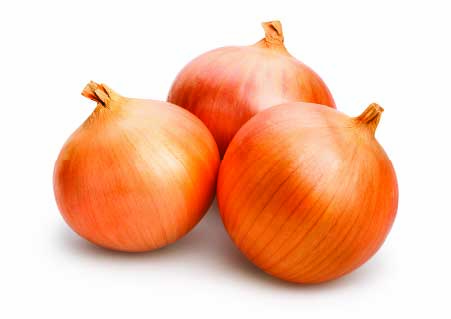a brief overview of the onion industry
For over 30 years, Boardman Foods has supplied the nation’s leading food manufacturers with premium Pacific Northwest onions grown close to our Northeast Oregon home. During this time, we’ve gained extensive knowledge about this critical ingredient in many cuisines that helps our customers make the best decisions regarding selection and sourcing.
What’s the difference between fresh onions and storage onions?
Freshly harvested and storage onions differ greatly in aesthetics and flavor, which typically determines how manufacturers use them in their products.

FRESH ONIONS
- Grown and harvested in the spring and summer
- Milder flavor due to their slightly higher water content
- Have a lighter skin with tissue paper texture
- Perfect for eating raw (e.g., salads or hamburgers)

STORAGE ONIONS
- Grown and harvested in the fall and winter
- Their higher solids content and enzymes give them a stronger flavor
- More robust skin allows for up to 10 months of storage
- Onion flavor compounds overpower sugars as bulb loses water and density in storage
- Perfect for soups and cooking in ready-to-eat entrees

What are the best domestic production areas for onions?
According to the National Onion Association, the United States has three primary growing areas for its onion supply. Where and when their growing season takes place informs the decision of the best products for their use:

What are the best domestic production areas for onions?
According to the National Onion Association, the United States has three primary growing areas for its onion supply. Where and when their growing season takes place informs the decision of the best products for their use:
Why did Boardman Foods choose Northeast Oregon as its base of operations?
When cousins Tom Flaherty and Brian Maag looked for the right place to build their new processing plant in the early 1990s, they realized that Boardman and the Port of Morrow offered the ideal home.
- Close to strong base of onion growers with well-developed and sustainable irrigation sources
- Viable clean water supply for processing operations
- Robust wastewater handling infrastructure
- Easy access to truck, rail, and barge transportation
- Affordable utility rates from sustainable suppliers
- Business climate suited to fostering long-term growth
What products does Boardman Foods provide food manufacturers?
As an industrial-scale ingredient supplier, we produce individually quick-frozen (IQF), whole peeled, and fresh (skin-on) onions for various purposes.

- Canned Soups
- Sauces
- Salsas
- Frozen Entrées
- Pizzas

- Fresh Soups
- Salsas

- Food service distributors, retail stores, and major terminal markets throughout the United States, Canada, and Mexico

How are onions grown?
Onions can be planted either using direct seeds (typically for storage crops) or transplants, also known as starts (typically for fresh markets). Most Columbia Basin onions are spring seeded.
An onion’s complete growth cycle lasts 5-6 months, with roughly two-thirds of the onion growing on top of the soil. Day length and latitude trigger bulbing, with the tops naturally going down when the onion has reached maturity.
How are onions irrigated?
There are three primary irrigation methods for onions, each with unique costs and benefits. Farmers in the Pacific Northwest use surface, pivot, and drip irrigation methods, with growers in the Columbia Basin primarily using pivot and drip systems.
The most popular irrigation method in our region is a pivot system, which uses a centrally anchored sprinkler system that slowly rotates over the field to evenly distribute water. Both water and nutrients can be delivered across 120-acre parcels with a single point of connection.
However, as farmers integrate cutting-edge farming techniques into their operations, state-of-the-art irrigation equipment and processes have become more widespread in the onion industry.
Drip systems distribute water through tubing directly into the root zone, minimizing evaporation and making them more efficient than other systems, often producing higher yields. However, these systems require extensive maintenance and are more capital-intensive than either pivot or surface systems.


Meanwhile, surface irrigation systems utilize gravity flow to water crops. They have the lowest technological barriers but are labor-intensive to implement. In addition, these systems require smoothly graded fields to allow even distribution of water. Thus, they are more popular in the Snake River and Treasure Valley regions of Eastern Oregon and Idaho.
What is the production process for the onion harvest?

After onions have reached maturity, growers lift them out of the ground and let them sit in the field to “cure” by forming a thick skin that is critical for storage onions.
Storage onions are often harvested mechanically, as their thicker skin and greater durability help the onions withstand rough, mechanized conveyance and piling. On the other hand, most fresh onions are harvested by hand to maintain their aesthetic qualities.
Once storage onions arrive at Boardman Foods, they are typically stored in bins or in bulk. A controlled atmosphere and proper ventilation extend their life and stability and allows us to use them throughout the year until the next crop is ready to harvest.
Congratulations!
We have so much we’d love to share with you about partnering with Boardman Foods for your industrial ingredient supply — much more than we can outline here. So, set up a preliminary meeting today with our team to learn more about how to meet your company’s needs.
You just completed
You’re almost an expert now.

